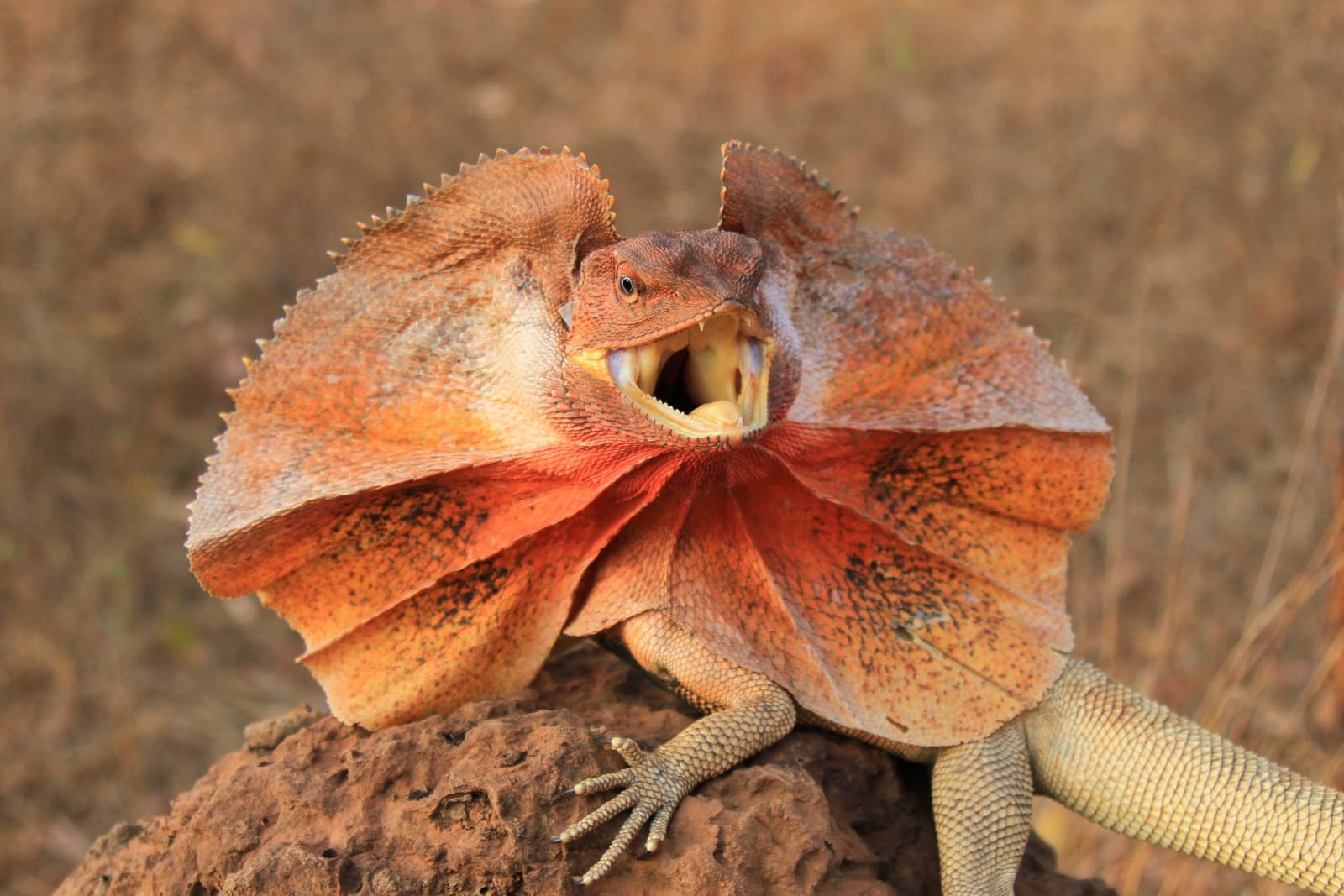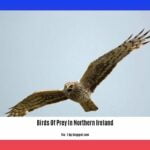Meet the frilled dragon lizard, a captivating creature that has walked the earth since the age of dinosaurs! This lizard sports a frilly neck resembling an Elizabethan collar, and it’s brimming with incredible adaptations that’ll leave you in awe. Let’s journey into the world of this prehistoric relic, exploring its remarkable biology, astonishing behaviors, and its enduring survival in today’s wild world.
Unveiling the Frilled Wonder
Ever heard of a lizard with a built-in cape? That’s our frilled dragon lizard, a creature straight out of prehistoric times, still thriving in Northern Australia and Southern New Guinea. Their enduring presence is a testament to their resilience.
What truly sets the frilled dragon lizard apart is its “frill” – a large, intricate fold of skin encircling its neck. This isn’t just a fashion statement; it’s a survival tactic. When threatened, this typically placid lizard transforms, flashing its frill as a warning signal. It’s a powerful way of saying, “Back off!”
A Master of Disguise and Survival
Even without its frill, this lizard is a camouflage expert. Cloaked in shades of gray and brown, it virtually melts into tree bark, a crucial defense against predators and a tool for surprising prey.
You’ll find the frilled dragon lizard basking in the sun’s warmth or seeking out insects and small animals in dry woodlands and savannas. Their lightning-fast, sticky tongues make them adept hunters.
Intriguing Behaviors and Conservation
Frilled dragons are solitary creatures, preferring their own company except during mating season. Though their fierce appearance might suggest otherwise, they’re not aggressive, relying on their frill and agility to avoid confrontation.
While not currently endangered, frilled dragons face challenges like habitat loss and poaching for the pet trade. By supporting conservation efforts and promoting responsible pet ownership, we can help ensure these fascinating creatures continue to thrive.
Is a Frilled Dragon the Right Pet for You? Unfrilling the Truth
Are you intrigued by frilled dragons, those prehistoric-looking lizards with the fancy neckwear, and wondering if they’d make good pets? They’re undeniably cool to look at and known for their laid-back demeanor. In fact, they’re often recommended for first-time reptile owners. But, like any pet, there are some things you should know before you bring one home.
Frilled Dragons as Pets: A Balanced Perspective
Pros:
- Docile and Calm: Frilled dragons are not known for aggression, making them relatively easy to handle for basic care.
- Low Maintenance: Compared to some other reptiles, their care is fairly straightforward, involving a proper diet, a well-set-up enclosure, and regular cleaning.
- Unique and Interesting: Their prehistoric appearance and iconic frill displays make them a captivating and unusual pet.
- Suitable for Beginners: Their relatively easy care makes them manageable for novice reptile owners willing to learn.
Cons:
- Not Cuddly: Frilled dragons are not affectionate and generally don’t enjoy being held for extended periods.
- Specialized Care: While their care is manageable, it requires specific knowledge about their diet, lighting, and humidity needs.
- Availability: They might not be as readily available as some other popular reptile pets.
Important Considerations:
- Handling: While frilled dragons tolerate handling for short periods, it’s best to prioritize observation over constant physical interaction.
- Enclosure: An arboreal setup is crucial, providing ample climbing space with branches, foliage, and a basking spot.
- Diet: As insectivores, they thrive on a diet of crickets, dubia roaches, and other appropriately sized insects dusted with calcium and vitamin supplements.
- Temperament: While generally docile, individual personalities can vary. Early socialization and gentle handling are essential.
Frilled Dragon Popularity:
Frilled dragons have seen a surge in popularity in recent years, possibly fueled by media portrayals and a growing interest in unique pets. However, they might not be as readily available as some more common reptile pets. Researching reputable breeders is essential.
Addressing Common Questions (People Also Ask):
- “Are frilled dragons good for beginners?”
- Yes, their care is manageable for beginners who educate themselves. However, they are not ideal for those seeking a highly interactive pet.
- “Can frilled dragons be kept together?”
- Generally, it’s not recommended. Females might cohabitate in a spacious enclosure with careful monitoring, but males are prone to territorial behavior.
- “Are frilled dragons a popular pet lizard?”
- Their popularity has surged in recent years, making them a more sought-after reptile pet.
Are you looking for unique pets? You should consider getting a freshwater blowfish. They are fascinating creatures that will add a touch of the exotic to your home.
If you are looking for a more traditional pet, you may want to consider a galago. These small primates are known for their big eyes and playful personalities.
Is a Frilled Dragon Venomous?
We’ve talked about frilled dragons and their impressive frills, but let’s address the elephant in the room: are these guys venomous?
The short answer? No, frilled dragons are not venomous.
Their real weapon is their flair for the dramatic! That huge frill they unfurl? That’s their go-to defense mechanism. Imagine a predator approaching, and suddenly, BAM! This giant, colorful shield flashes open. It’s enough to make anyone jump back in surprise.
The frill also makes the dragon look much larger than it really is, like an instant lizard power-up! But there’s more to their defense than meets the eye. If the frill fails to deter a threat, they’re surprisingly quick on their feet. These lizards can run on their hind legs, making a hasty retreat.
And if that doesn’t work, their camouflage skills might just save the day. They blend into their surroundings so well that a predator might walk right past them.
Diet and Demeanor
Frilled dragons are insectivores, using their sharp claws and teeth to catch and devour bugs. This diet aligns with the fact that venomous creatures usually reserve their venom for larger prey.
Despite their fierce looks, frilled dragons are actually quite docile. They’d much rather show off their frill than pick a fight. Even if they do bite, it’s usually out of self-defense and is not considered dangerous.
Of course, like any animal, frilled dragons deserve respect. If you’re lucky enough to have one as a pet, ensure you’re providing the right environment and diet — essentially, a little piece of Australia in your home.
Let’s not forget about their wild counterparts! Habitat loss and illegal pet trade are real threats, so it’s crucial that we protect them and their habitats.
Unleashing the Frill-Power: A Deep Dive into Frilled Dragon Friendliness
You might think a creature with a giant, spiky frill is always ready for a brawl, but frilled dragons aren’t looking for a fight. That impressive frill? It’s all for show! Think of it as their personal “Back off!” sign.
So, while they might not be aggressive, that doesn’t mean they’re going to be cuddly lap lizards either. Most frilled dragons are content to observe the world from their terrariums. They’d much rather watch than be handled, and they won’t hesitate to flash that famous frill if they’re feeling stressed or overwhelmed.
But here’s the thing: with plenty of patience and a gentle touch, some frilled dragons can become quite comfortable around humans. It takes time and understanding to earn their trust.
Friendliness and Temperament:
- Docile Nature: Frilled dragons are not naturally aggressive towards humans.
- Bonding Potential: They are capable of developing strong bonds with their owners, making them more than just display animals.
- Tameness Through Handling: Regular, gentle handling is crucial for taming frilled dragons and acclimating them to human interaction.
- Not Cuddly Lizards: While they can tolerate handling, they generally don’t enjoy being held for long periods.
- Beginner Friendly: Their generally docile nature and relatively simple care requirements make them a suitable choice for first-time reptile owners who are willing to do their research.
Important Considerations:
- Individual Personalities: Like any animal, frilled dragons have individual personalities. Some may be more receptive to handling and interaction than others.
- “Frilled” Display is Defensive: Their iconic frill display is a defense mechanism, used when they feel threatened. Understanding their body language is important to avoid stressing them.
- Socialization and Handling from a Young Age: Starting handling early and continuing consistently is vital to developing a trusting bond.
Key Points to Remember:
- Unique Feature: Frilled dragon lizards have a large, intricate fold of skin called a “frill” around their neck.
- Defensive Mechanism: When threatened, they flash their frill as a warning signal to deter predators.
- Master of Camouflage: Their gray and brown coloration allows them to blend seamlessly into their tree bark surroundings.
- Habitat: Dry woodlands and savannas, where they prefer to perch in branches.
- Diet: Insects and small animals, which they catch with their sticky tongues.
- Social Behavior: Solitary creatures that only interact for mating purposes.
- Conservation Status: Currently not endangered but face challenges from habitat loss and illegal pet trade.
- Future: Protecting and conserving the frilled dragon lizard requires public awareness and support for conservation efforts.
- Unlocking 2-Letter Words with U: The Definitive Guide - April 4, 2025
- Unlock Words with the Letters THREE: Top Unscramble Tools 2025 - April 4, 2025
- Master Scrabble: X & Z Words for High Scores - April 4, 2025
















